zabbix监控服务
第一章 监控知识基本概述
1.为什么要使用监控
1.对系统不间断实时监控
2.实时反馈系统当前状态
3.保证服务可靠性安全性
4.保证业务持续稳定运行
2.如何进行监控,比如我们需要监控磁盘的使用率
1.如何查看磁盘使用率 df -h
2.监控磁盘的那些指标 block、 inode
3.如何获取具体的信息 df -h|awk '//(NF-1)}'
4.获取的数值到达多少报警 80%
3.流行的监控工具
1.Zabbix
2.Lepus(天兔)数据库监控系统
3.Open-Falcon 小米
4.Prometheus(普罗米修斯, Docker、 K8s)
4.如果去到一家新公司,如何入手监控
1.硬件监控 路由器、交换机、防火墙
2.系统监控 CPU、内存、磁盘、网络、进程、 TCP
3.服务监控 nginx、 php、 tomcat、 redis、 memcache、 mysql
4.WEB 监控 请求时间、响应时间、加载时间、
5.日志监控 ELk(收集、存储、分析、展示) 日志易
6.安全监控 Firewalld、 WAF(Nginx+lua)、安全宝、牛盾云、安全狗
7.网络监控 smokeping 多机房
8.业务监控 活动引入多少流量、产生多少注册量、带来多大价值
第二章 单机时代如何监控
CPU 监控命令: w、 top、 htop、 glances
%Cpu(s): 0.3 us, 0.3 sy, 0.0 ni, 99.3 id, 0.0 wa, 0.0 hi, 0.0 si, 0.0 st
us 用户态: 跟用户的操作有关 35%
sy 系统态: 跟内核的处理有关 60%
id CPU 空闲:
内存监控命令: free
[root@m01 ~]# free -h
total used free shared buff/cache available
Mem: 977M 105M 724M 6.6M 148M 729M
Swap: 1.0G 0B 1.0G
磁盘监控命令: df、 iotop
Device: tps kB_read/s kB_wrtn/s kB_read kB_wrtn
sda 0.80 25.32 33.36 221034 291193
设备名 每秒传输次数 每秒读大小 每秒写大小 读的总大小 写的总大小
网络监控命令: ifconfig、 route、 glances、 iftop、 nethogs、 netstat
单位换算
Mbps 100Mbps/8
MB 12MB
iftop 中间的<= =>这两个左右箭头,表示的是流量的方向。
TX:发送流量、 RX:接收流量、 TOTAL:总流量
#查看 TCP11 中状态
netstat -an|grep ESTABLISHED
netstat -rn # 查看路由信息
netstat -lntup
2.随着时间的推移,用户不断的增多,服务随时可能扛不住会被 oom(out of memory),当系统内存不足的时候,会触发 oom
1.当系统内存不足的时候就会大量使用 swap
2.当系统大量使用 swap 的时候,系统会特别卡
注意: 有时可能内存还有剩余 300Mb-500Mb,但会发现 swap 依然被使用
[root@ZabbixServer ~]# dd if=/dev/zero of=/dev/null bs=800M
[root@ZabbixServer ~]# tail -f /var/log/messages
Out of memory: Kill process 2227 (dd) score 778 or sacrifice child
Killed process 2227 (dd) total-vm:906724kB, anon-rss:798820kB, file-rss:0kB
3.那单机时代,如何使用 shell 脚本来实现服务器的监控
需求: 每隔 1 分钟监控一次内存,当你的可用内存低于 100m,发邮件报警,要求显示剩余内存
1.怎么获取内存可用的值 free -m|awk '/^Mem/{print $NF}'
2.获取到内存可用的值如何和设定的阈值进行比较
3.比较如果大于 100m 则不处理,如果小于 100 则报警
4.如何每隔 1 分钟执行一次
[root@ZabbixServer ~]# cat free.sh
#!/usr/bin/bash
HostName=$(hostname)_$(hostname -i)
Date=$(date +%F)
while true;do
Free=$(free -m|awk '/^Mem/{print $NF}')
if [ $Free -le 100 ];then
echo "$Date: $HostName Mem Is < ${Free}MB"
fi
sleep 5
done
第三章 zabbix 监控快速安装
1.配置zabbix仓库
#清华源
[root@m01 ~]# rpm -ivh https://mirrors.tuna.tsinghua.edu.cn/zabbix/zabbix/4.0/rhel/7/x86_64/zabbix-release-4.0-1.el7.noarch.rpm
#阿里云源
rpm -ivh https://mirrors.aliyun.com/zabbix/zabbix/4.0/rhel/7/x86_64/zabbix-release-4.0-1.el7.noarch.rpm
#替换zabbix源为阿里云源
cat >/etc/yum.repos.d/zabbix.repo<<EOF
[zabbix]
name=Zabbix Official Repository - \$basearch
baseurl=https://mirrors.aliyun.com/zabbix/zabbix/4.0/rhel/7/\$basearch/
enabled=1
gpgcheck=1
gpgkey=file:///etc/pki/rpm-gpg/RPM-GPG-KEY-ZABBIX-A14FE591
[zabbix-non-supported]
name=Zabbix Official Repository non-supported - \$basearch
baseurl=https://mirrors.aliyun.com/zabbix/non-supported/rhel/7/\$basearch/
enabled=1
gpgkey=file:///etc/pki/rpm-gpg/RPM-GPG-KEY-ZABBIX
gpgcheck=1
EOF
2.安装 Zabbix 程序包,以及 MySQL、 Zabbix-agent
#更新缓存并安装
[root@m01 ~]# yum makecache fast
[root@m01 ~]# yum install -y zabbix-server-mysql zabbix-web-mysql zabbix-agent mariadb-server
[root@m01 ~]# systemctl start mariadb.service && systemctl enable mariadb.service
3.创建 Zabbix 数据库以及用户
[root@m01 ~]# mysqladmin password 123456
[root@m01 ~]# mysql -uroot -p123456
MariaDB [(none)]> create database zabbix character set utf8 collate utf8_bin;
MariaDB [(none)]> grant all privileges on zabbix.* to zabbix@localhost identified by 'zabbix';
MariaDB [(none)]> flush privileges;
4.导入 Zabbix 数据至数据库中
[root@m01 ~]# zcat /usr/share/doc/zabbix-server-mysql-4.0.11/create.sql.gz | mysql -uzabbix -pzabbix zabbix
5.编辑/etc/zabbix/zabbix_server.conf 文件,修改数据库配置
[root@m01 ~]# grep "^[a-Z]" /etc/zabbix/zabbix_server.conf
...............
DBHost=localhost
DBName=zabbix
DBUser=zabbix
DBPassword=zabbix
...............
6.启动 Zabbix 服务进程,并加入开机自启
[root@m01 ~]# systemctl start zabbix-server.service
[root@m01 ~]# systemctl enable zabbix-server.service
7.配置 Apache 的配置文件/etc/httpd/conf.d/zabbix.conf,修改时区
[root@m01 ~]# grep "timezone" /etc/httpd/conf.d/zabbix.conf
php_value date.timezone Asia/Shanghai
8.重启 Apache Web 服务器
[root@m01 ~]# systemctl start httpd
[root@m01 ~]# systemctl enable httpd
#词汇表
zabbix-server :负责接收agent的数据,分析并存入mysql
zabbix-agent :负责采集客户端的数据并发送给zabbix-server
zabbix-web : 负责展示,过滤,配置监控项,触发器,报警媒介
mysql :实际负责存储数据
监控项 :每一个实际的监控内容
自定义监控项 :默认监控模板没有的监控内容,需要自己自定义的监控
应用集 : 把监控项分类划分
触发器 :监控项的报警阈值
报警媒介 :报警的方式 微信 邮件
图形 :监控项历史记录的趋势图,多个监控项可以一起展示
聚合图形 :多个图形可以组合成一个更大的图形
模板 :
第四章 WEB安装步骤
1.浏览器打开地址:http://10.0.1.61/zabbix/setup.php
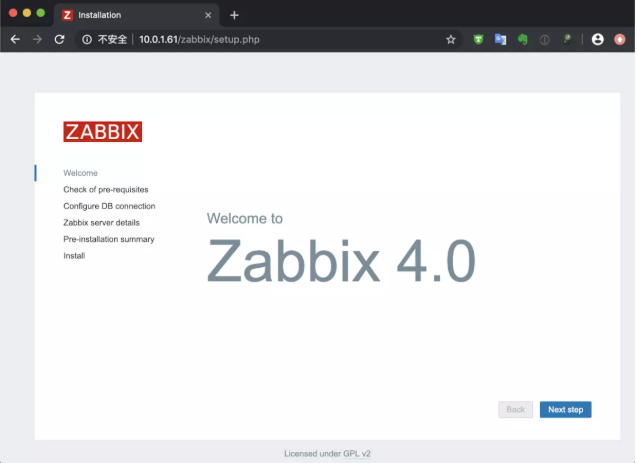
2.检查依赖项是否存在异常
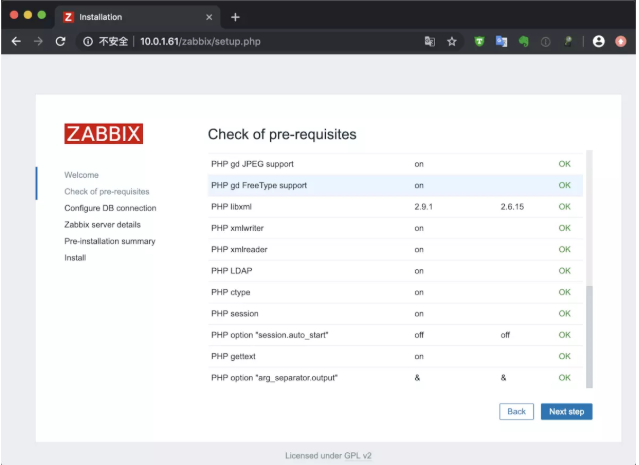
3.配置zabbix连接数据库
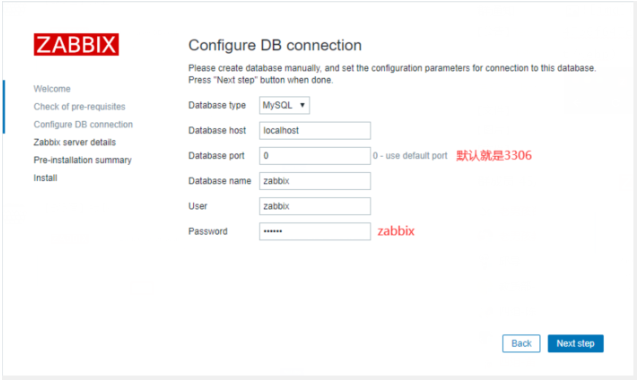
4.配置 ZabbixServer 服务器的信息
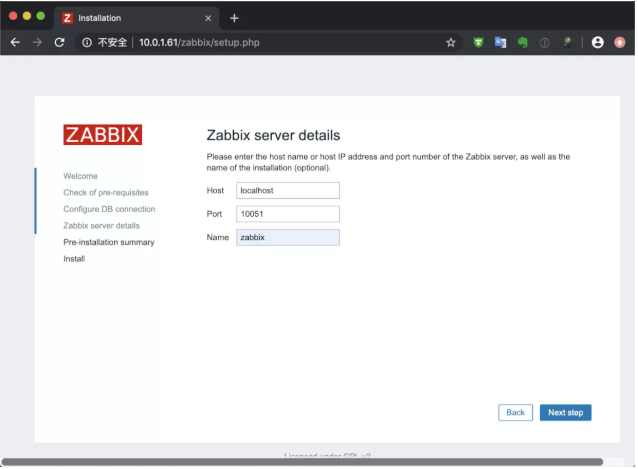
5.最终确认检查
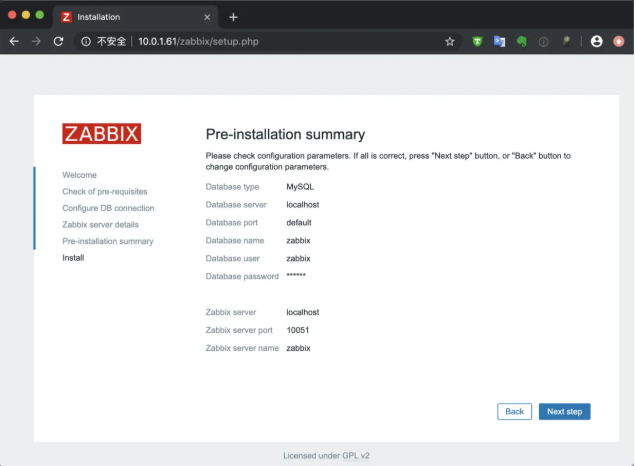
6.安装成功
提示已成功地安装了 Zabbix 前端。配置文件/etc/zabbix/web/zabbix.conf.php 被创建。
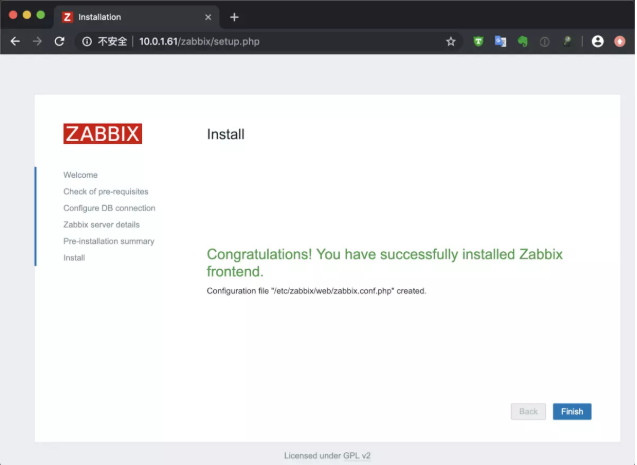
7.登陆zabbix
默认登陆 ZabbixWeb 的用户名 Admin,密码 zabbix
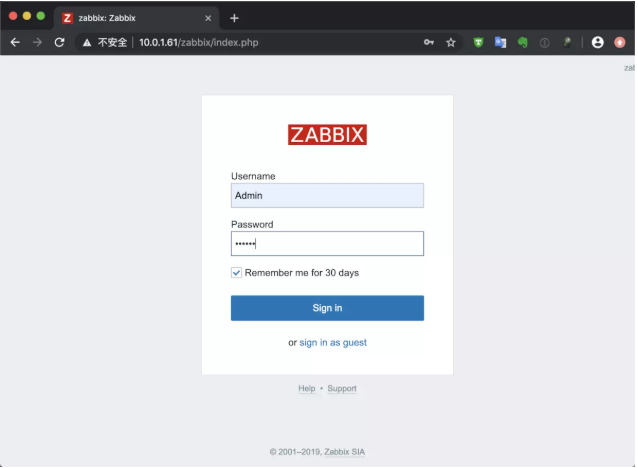
8.调整字符集为中文
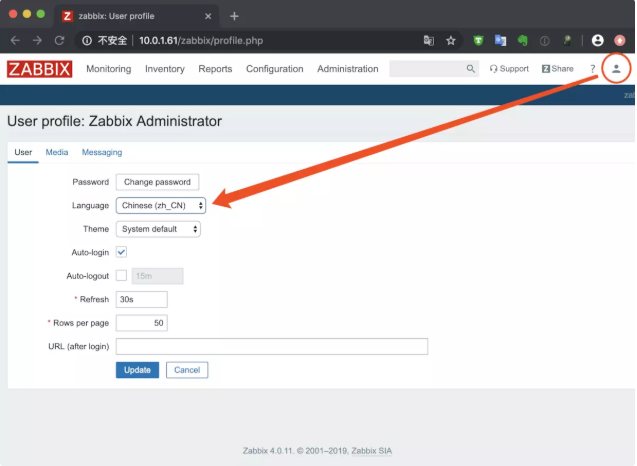
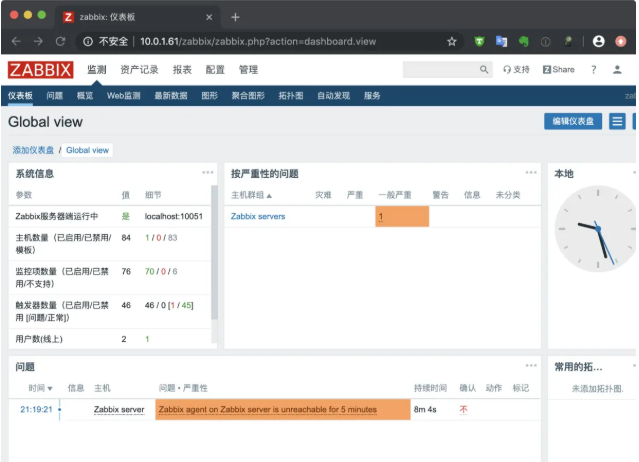
9.修复中文乱码
打开图形之后会发现语言为乱码,原因是缺少字体
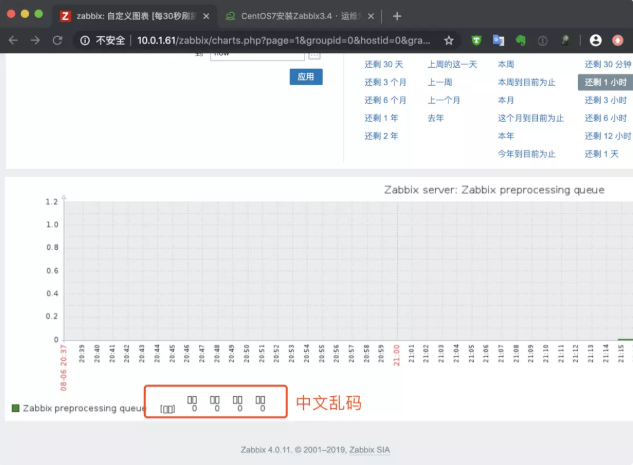
解决方法:安装字体并替换现有字体
[root@m01 ~]# yum install wqy-microhei-fonts -y
[root@m01 ~]# cp /usr/share/fonts/wqy-microhei/wqy-microhei.ttc /usr/share/zabbix/assets/fonts/graphfont.ttf
再次刷新发现已经变成中文了

第五章 Zabbix 监控基础架构
zabbix-agent(数据采集)—>zabbix-server(数据分析|报警)—> 数据库(数据存储)<—zabbix web(数据展示)
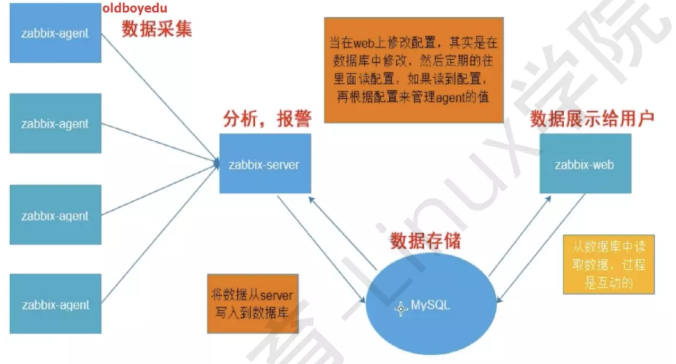
第六章 zabbix 快速监控主机
1.安装zabbix-agent
#清华源
[root@web01 ~]# rpm -ivh https://mirror.tuna.tsinghua.edu.cn/zabbix/zabbix/4.0/rhel/7/x86_64/zabbix-agent-4.0.11-1.el7.x86_64.rpm
#阿里云源
rpm -ivh https://mirrors.aliyun.com/zabbix/zabbix/4.0/rhel/7/x86_64/zabbix-agent-4.0.11-1.el7.x86_64.rpm
2.配置zabbix-agent
[root@web01 ~]# grep "^[a-Z]" /etc/zabbix/zabbix_agentd.conf
PidFile=/var/run/zabbix/zabbix_agentd.pid
LogFile=/var/log/zabbix/zabbix_agentd.log
LogFileSize=0
Server=10.0.1.61
ServerActive=127.0.0.1
Hostname=Zabbix server
Include=/etc/zabbix/zabbix_agentd.d/*.conf
3.启动zabbix-agent并检查
[root@web01 ~]# systemctl start zabbix-agent.service
[root@web01 ~]# systemctl enable zabbix-agent.service
[root@web01 ~]# netstat -lntup|grep 10050
tcp 0 0 0.0.0.0:10050 0.0.0.0:* LISTEN 10351/zabbix_agentd
tcp6 0 0 :::10050 :::* LISTEN 10351/zabbix_agentd
4.zabbix-web界面,添加主机
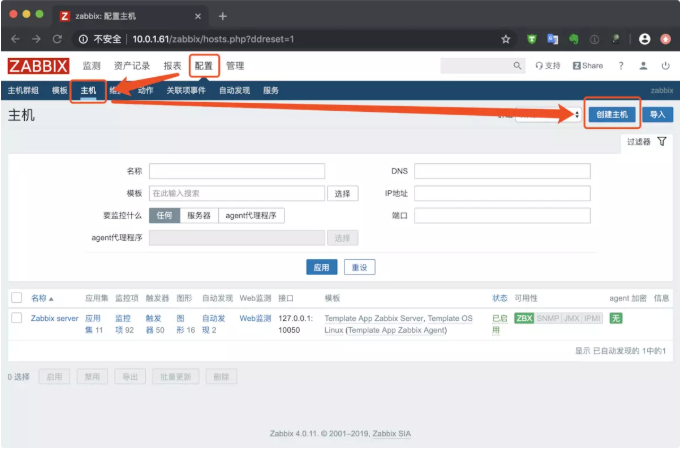
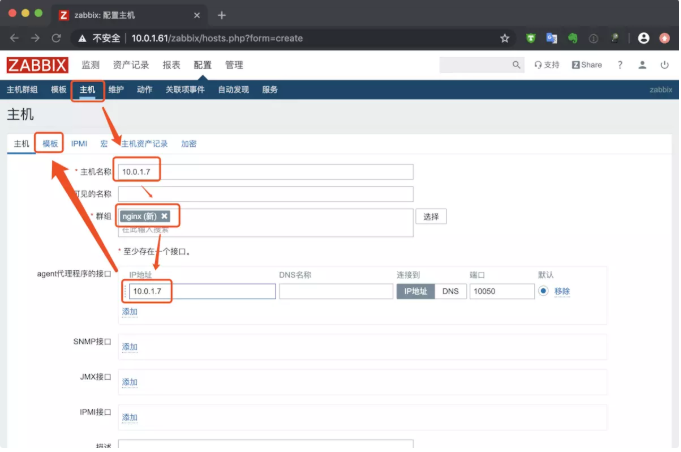
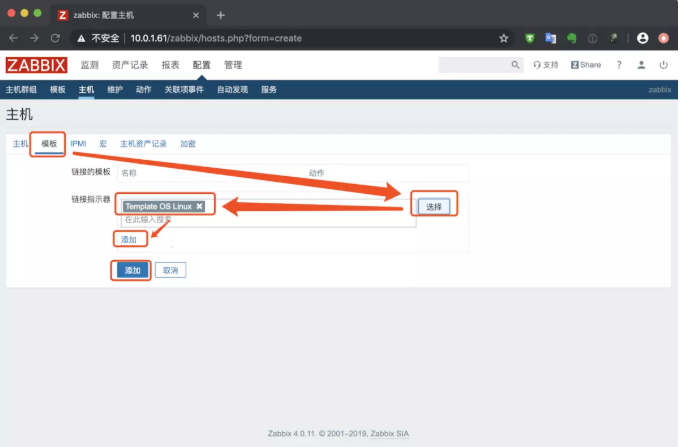
第七章 自定义监控主机小试身手
1.监控需求
监控TCP11种状态集
2.命令行实现
[root@web01 ~]# netstat -ant|grep -c TIME_WAIT
55
[root@web01 ~]# netstat -ant|grep -c LISTEN
12
3.编写zabbix监控文件(传参形式)
[root@web01 ~]# cat /etc/zabbix/zabbix_agentd.d/tcp_status.conf
UserParameter=tcp_state[*],netstat -ant|grep -c $1
root@web01 ~]# systemctl restart zabbix-agent.service
4.server端进行测试
[root@m01 ~]# rpm -ivh https://mirrors.tuna.tsinghua.edu.cn/zabbix/zabbix/4.0/rhel/7/x86_64/zabbix-release-4.0-1.el7.noarch.rpm
[root@m01 ~]# yum install zabbix-get.x86_64 -y
[root@m01 ~]# zabbix_get -s 10.0.1.7 -k tcp_state[TIME_WAIT]
51
[root@m01 ~]# zabbix_get -s 10.0.1.7 -k tcp_state[LISTEN]
12
5.web端添加
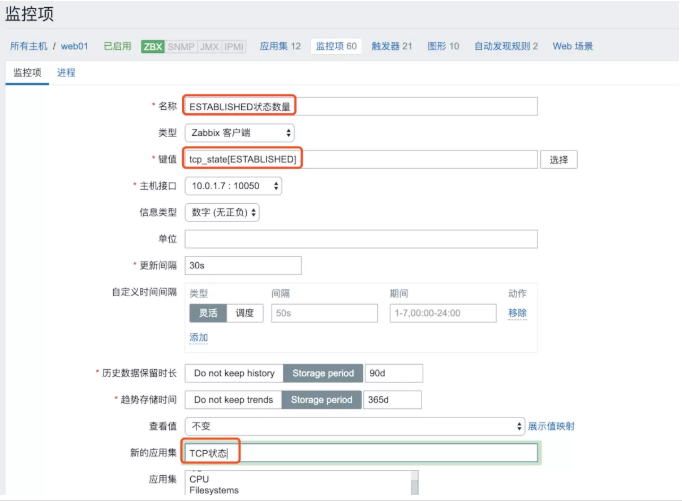
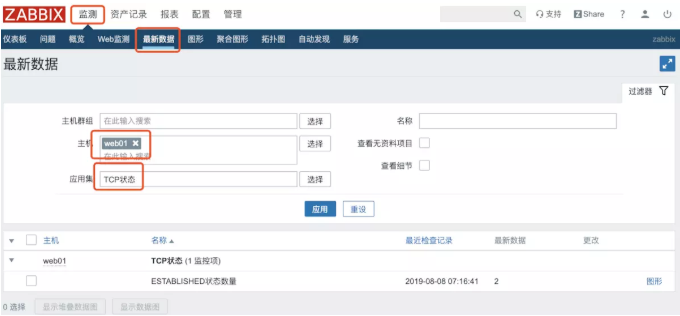
6.克隆监控项
由于TCP有多种状态,需要添加多个监控项,我们可以使用克隆快速达到创建的效果
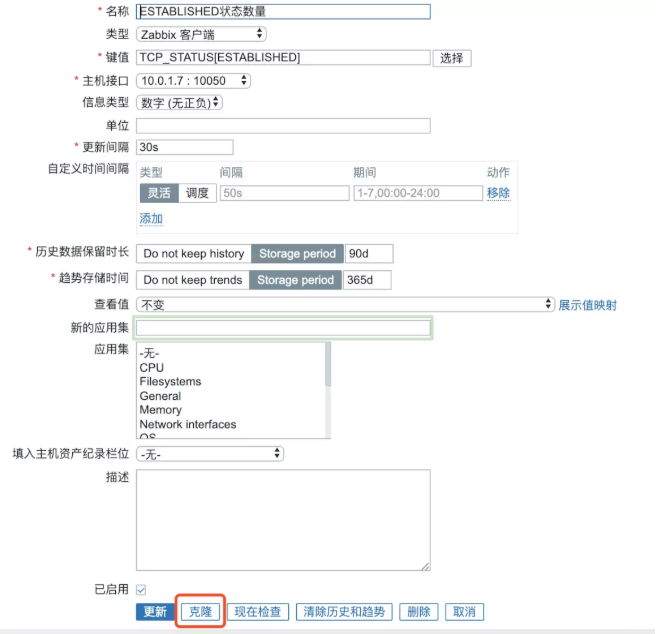
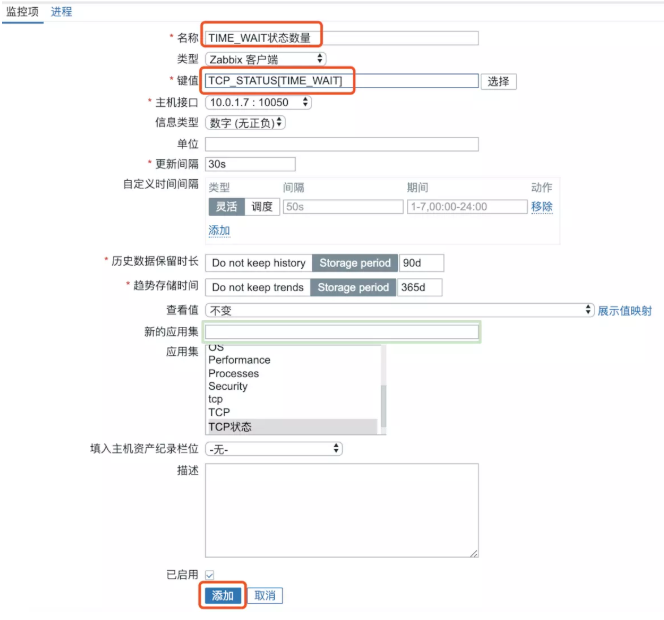
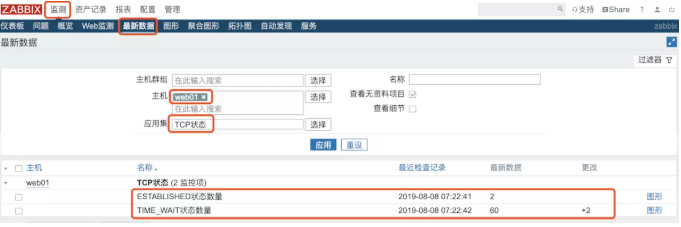
其他的状态依次添加即可
7.创建图形
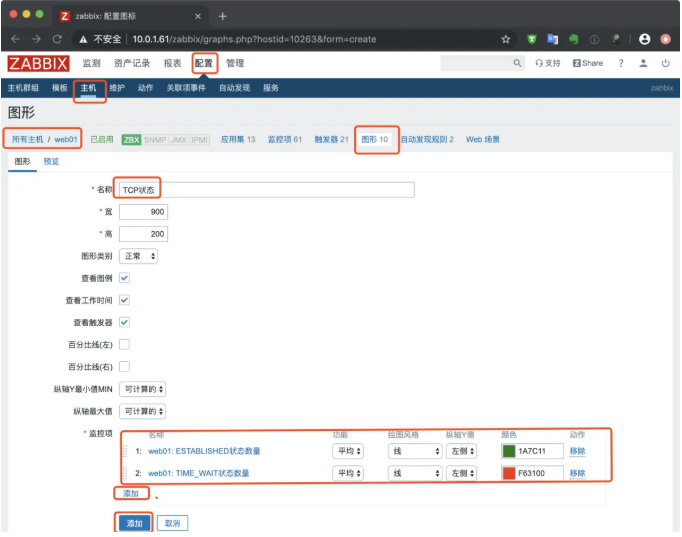
8.查看图形
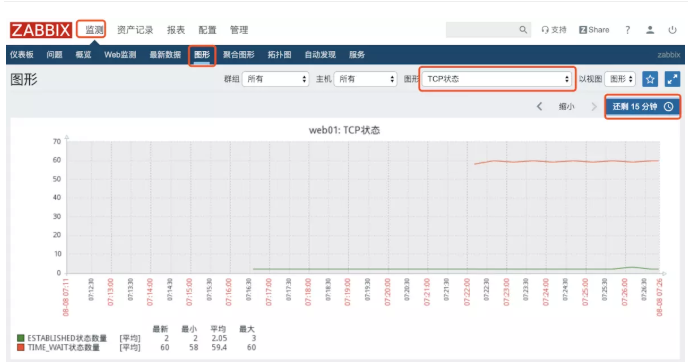
9.设置触发器
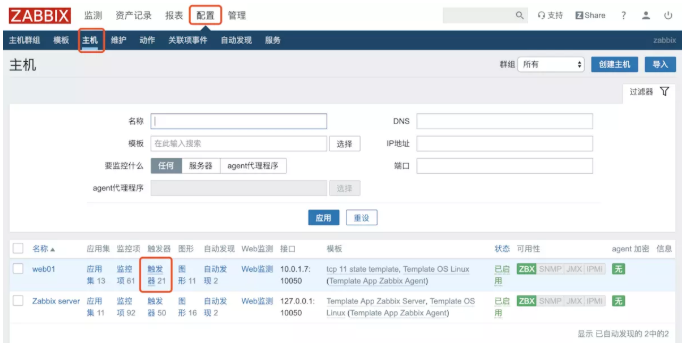
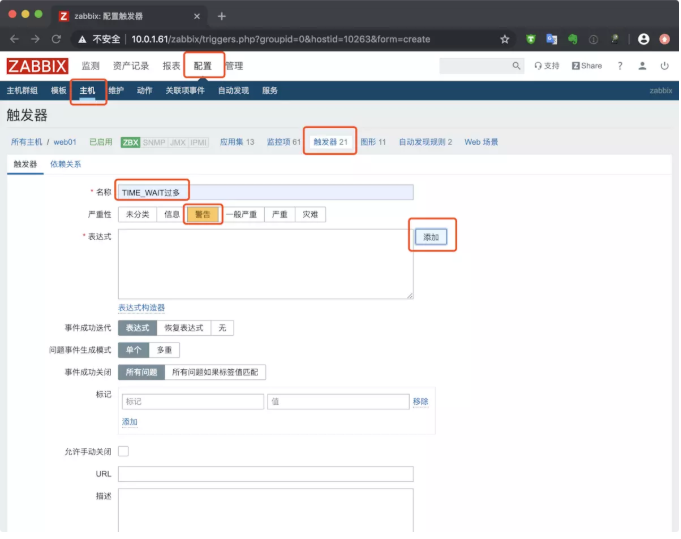
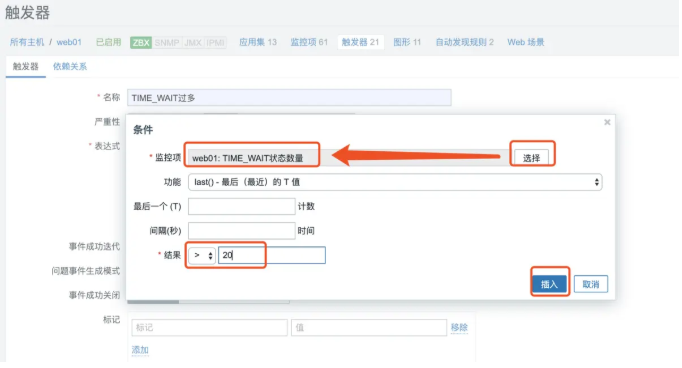
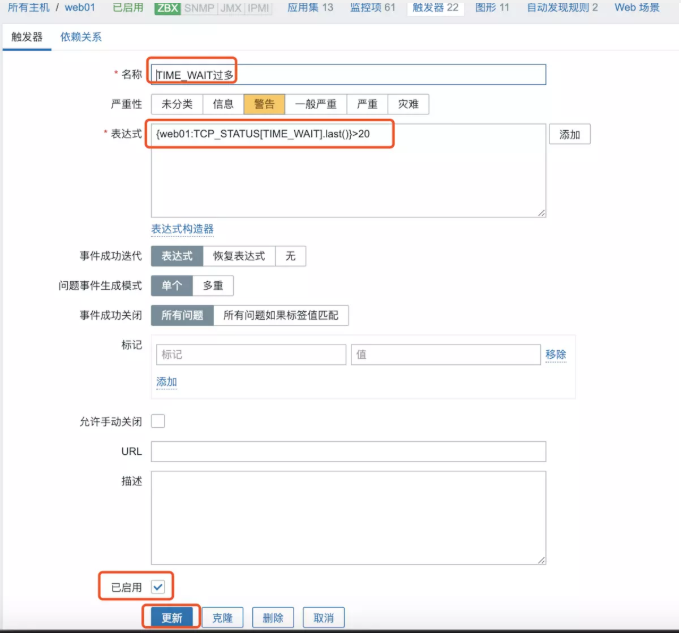
第八章 邮件报警
1.定义发件人
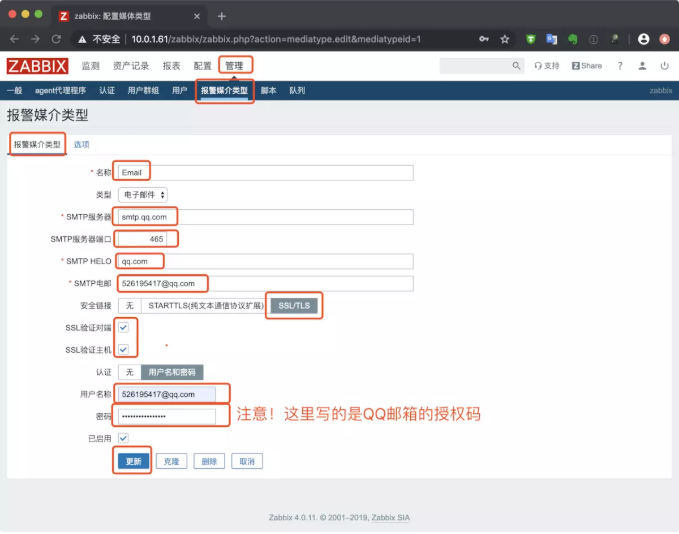
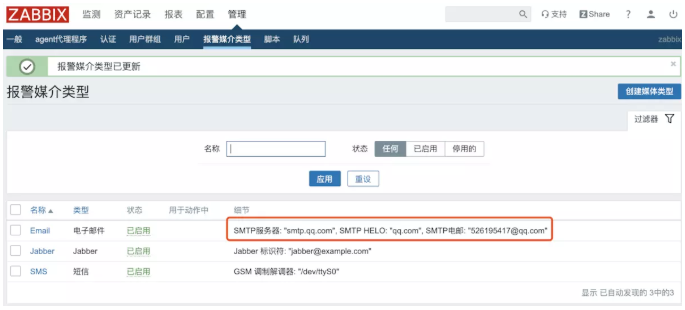
2.定义收件人
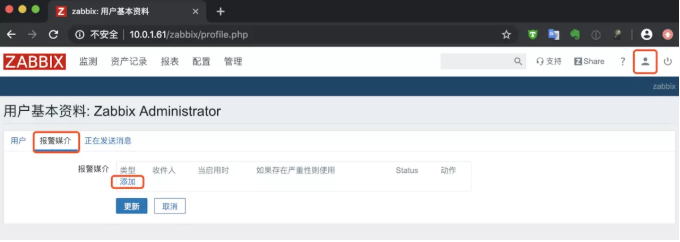
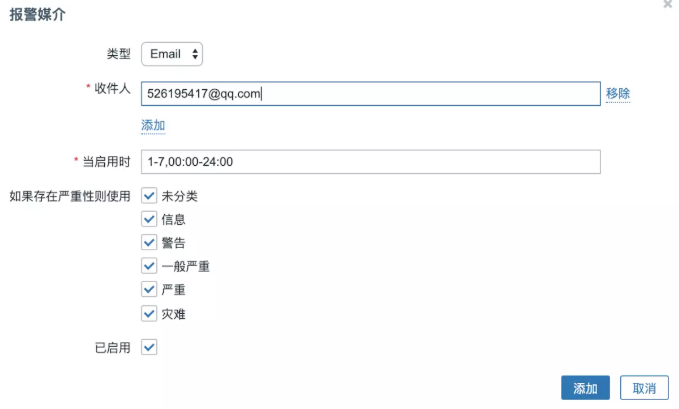
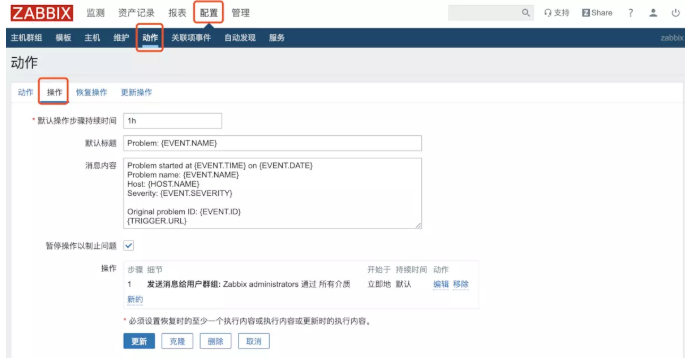
3.自定义报警内容
定制报警内容:
https://www.zabbix.com/documentation/4.0/zh/manual/appendix/macros/supported_by_location
参考博客
https://www.cnblogs.com/bixiaoyu/p/7302541.html
发送警告
报警邮件标题可以使用默认信息,亦可使用如下中文报警内容
名称:Action-Email
发送标题:
---------------------------------------------------------------------
故障{TRIGGER.STATUS},服务器:{HOSTNAME1}发生: {TRIGGER.NAME}故障!
---------------------------------------------------------------------
发送警告消息内容:
---------------------------------------------------------------------
告警主机:{HOSTNAME1}
告警时间:{EVENT.DATE} {EVENT.TIME}
告警等级:{TRIGGER.SEVERITY}
告警信息: {TRIGGER.NAME}
告警项目:{TRIGGER.KEY1}
问题详情:{ITEM.NAME}:{ITEM.VALUE}
当前状态:{TRIGGER.STATUS}:{ITEM.VALUE1}
事件ID:{EVENT.ID}
---------------------------------------------------------------------
恢复警告
恢复标题:
---------------------------------------------------------------------
恢复{TRIGGER.STATUS}, 服务器:{HOSTNAME1}: {TRIGGER.NAME}已恢复!
---------------------------------------------------------------------
恢复信息:
---------------------------------------------------------------------
告警主机:{HOSTNAME1}
告警时间:{EVENT.DATE} {EVENT.TIME}
告警等级:{TRIGGER.SEVERITY}
告警信息: {TRIGGER.NAME}
告警项目:{TRIGGER.KEY1}
问题详情:{ITEM.NAME}:{ITEM.VALUE}
当前状态:{TRIGGER.STATUS}:{ITEM.VALUE1}
事件ID:{EVENT.ID}
---------------------------------------------------------------------
第九章 微信报警
1.查看配置文件里的脚本目录路径
[root@m01 ~]# grep "^AlertScriptsPath" /etc/zabbix/zabbix_server.conf
AlertScriptsPath=/usr/lib/zabbix/alertscripts
2.将weixin.py放在zabbix特定目录
[root@m01 /usr/lib/zabbix/alertscripts]# ll
总用量 4
-rwxr-xr-x 1 root root 1344 8月 7 21:58 weixin.py
3.配置发信人


4.配置收信人

5.登陆企业微信公众号添加账户
https://work.weixin.qq.com/wework_admin/loginpage_wx
1.登陆后在企业号上新建应用

2.上传logo,填写应用名称 ,应用介绍等

3.查看启动应用同时会生成应用的AgentId以及Secret,这个在后面步骤会有用

4.接口调用测试http://work.weixin.qq.com/api/devtools/devtool.php

这里的corpid为公司ID

Corpsecret就是刚才创建应用生成的Secrt,确认没问题填写进去然后下一步如果没问题会显示200状态码
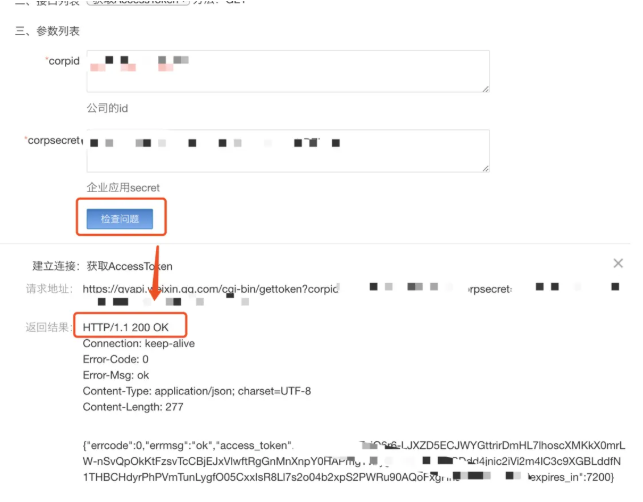
6.添加成员

7.关注公众号

8.查看自己的账号

9.修改脚本里的信息
[root@m01 /usr/lib/zabbix/alertscripts]# cat weixin.py
..............
corpid='微信企业号corpid'
appsecret='应用的Secret'
agentid=应用的id
..............
10.发信测试
[root@m01 /usr/lib/zabbix/alertscripts]# python weixin.py 你的账号 '发信测试' ‘微信测试消息’
11.微信号上查看

12.发送到整个微信组
虽然我们实现了发送到单个用户的功能,但是如果我们的用户比较多,这样还是麻烦的,不过我们可以发送到整个组,其实脚本里已经预留好了配置,只不过默认注释了。
将脚本修改为以下内容,注释掉用户,打开组设置
#!/usr/bin/env python
import requests
import sys
import os
import json
import logging
logging.basicConfig(level = logging.DEBUG, format = '%(asctime)s, %(filename)s, %(levelname)s, %(message)s',
datefmt = '%a, %d %b %Y %H:%M:%S',
filename = os.path.join('/tmp','weixin.log'),
filemode = 'a')
corpid='wwd26fdfb9940e7efa'
appsecret='Btg89FnZfMu0k7l6b4iagmAR5Z9TCgKknYbx-SMQvmg'
agentid=1000005
token_url='https://qyapi.weixin.qq.com/cgi-bin/gettoken?corpid=' + corpid + '&corpsecret=' + appsecret
req=requests.get(token_url)
accesstoken=req.json()['access_token']
msgsend_url='https://qyapi.weixin.qq.com/cgi-bin/message/send?access_token=' + accesstoken
#touser=sys.argv[1]
toparty=sys.argv[1]
subject=sys.argv[2]
message=sys.argv[2] + "\n\n" +sys.argv[3]
params={
#"touser": touser,
"toparty": toparty,
"msgtype": "text",
"agentid": agentid,
"text": {
"content": message
},
"safe":0
}
req=requests.post(msgsend_url, data=json.dumps(params))
logging.info('sendto:' + toparty + ';;subject:' + subject + ';;message:' + message)
13.随机发送到指定用户玩笑脚本
#!/bin/bash
num=$(echo $(($RANDOM%28+1)))
name=$(sed -n "${num}p" name.txt)
ok_boy=$(grep -v "${name}" name.txt)
for ok in ${ok_boy}
do
python weixin.py ${ok} "$1" "$2"
done
第十章 自定义模版
1.监控TCP11种状态
编写zabbix配置文件
[root@web01 /etc/zabbix/zabbix_agentd.d]# cat zbx_tcp.conf
UserParameter=ESTABLISHED,netstat -ant|grep -c 'ESTABLISHED'
UserParameter=SYN_SENT,netstat -ant|grep -c 'SYN_SENT'
UserParameter=SYN_RECV,netstat -ant|grep -c 'SYN_RECV'
UserParameter=FIN_WAIT1,netstat -ant|grep -c 'FIN_WAIT1'
UserParameter=FIN_WAIT2,netstat -ant|grep -c 'FIN_WAIT2'
UserParameter=TIME_WAIT,netstat -ant|grep -c 'TIME_WAIT'
UserParameter=CLOSE,netstat -ant|grep -c 'CLOSE'
UserParameter=CLOSE_WAIT,netstat -ant|grep -c 'CLOSE_WAIT'
UserParameter=LAST_ACK,netstat -ant|grep -c 'LAST_ACK'
UserParameter=LISTEN,netstat -ant|grep -c 'LISTEN'
UserParameter=CLOSING,netstat -ant|grep -c 'CLOSING'
2.重启zabbix-agent
[root@web01 ~]# systemctl restart zabbix-agent.service
3.测试监控项
使用zabbix-get命令测试
[root@m01 ~]# yum install zabbix-get.x86_64 -y
[root@m01 ~]# zabbix_get -s 10.0.1.7 -k ESTABLISHED
2
[root@m01 ~]# zabbix_get -s 10.0.1.7 -k LISTEN
12
4.创建模板

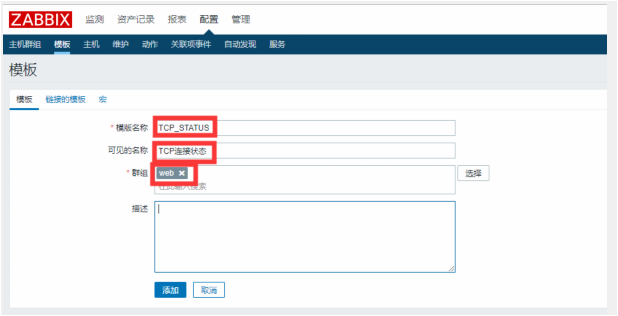
编辑模板

添加应用集
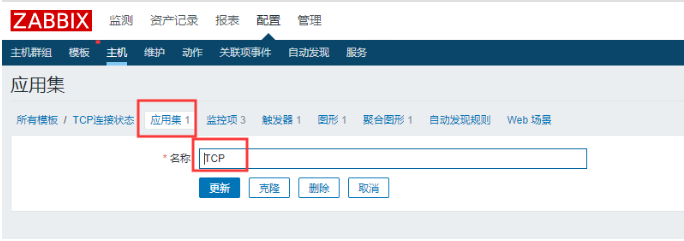
添加监控项
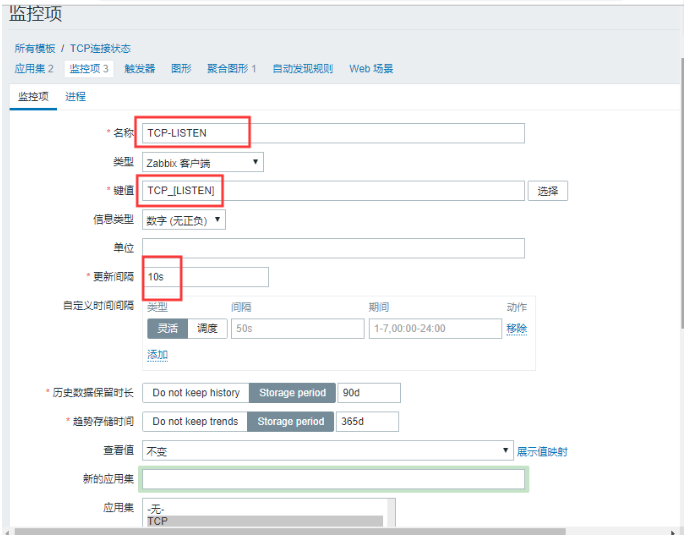

创建触发器

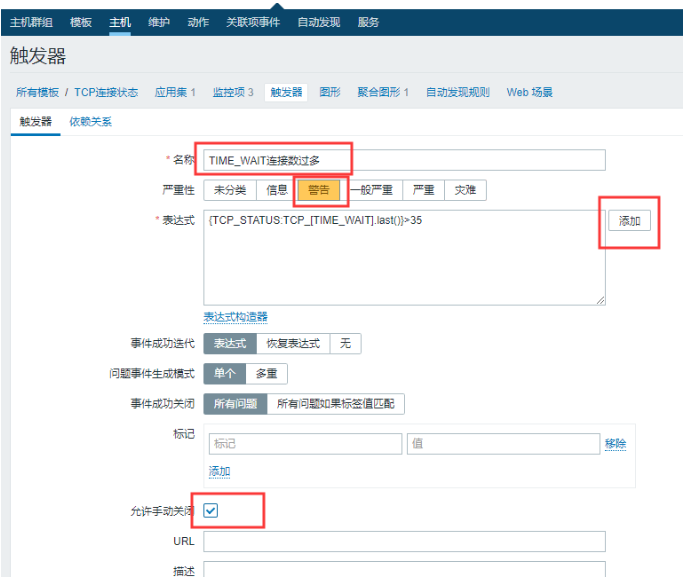
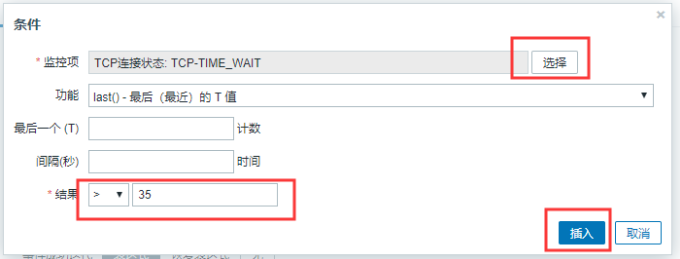

创建图形
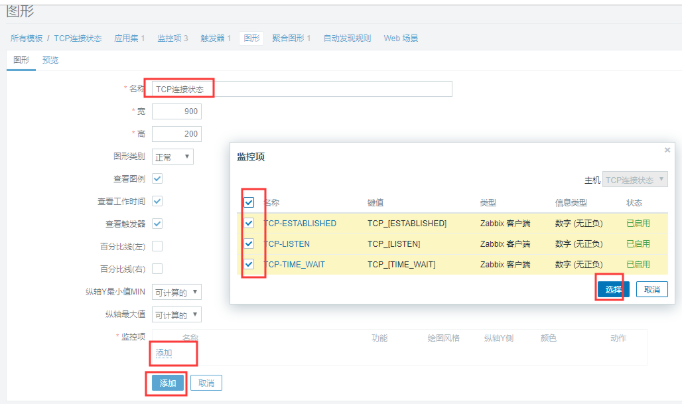

导出模板
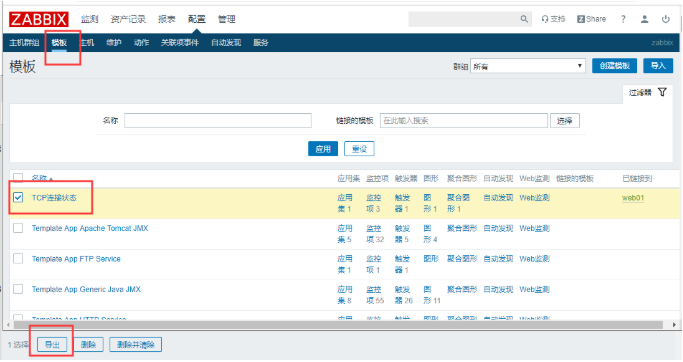
5.导入模版文件

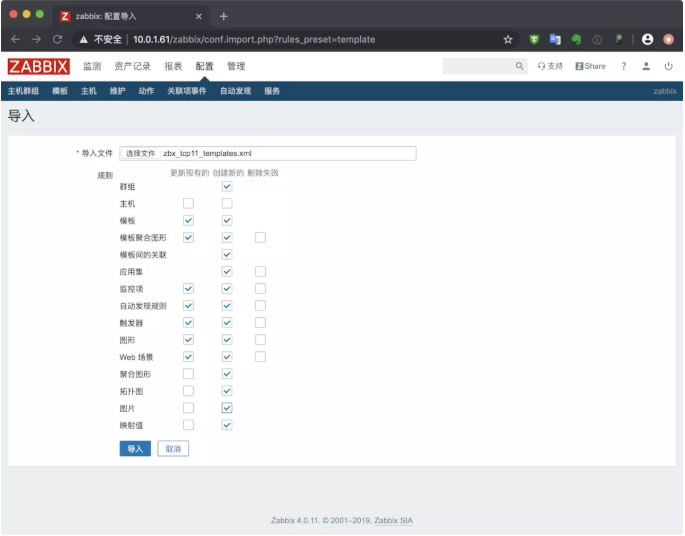
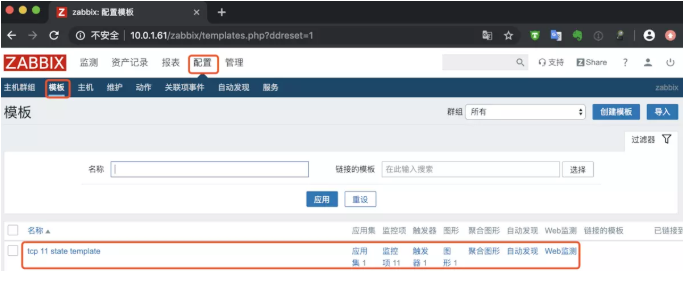
6.主机关联模版文件
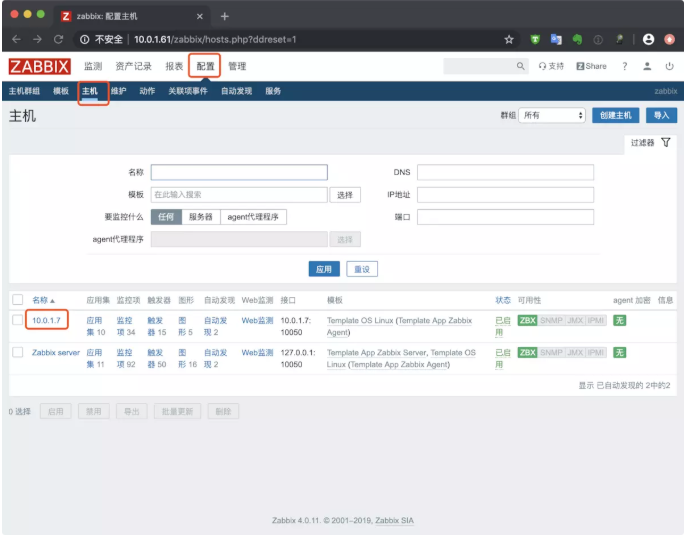
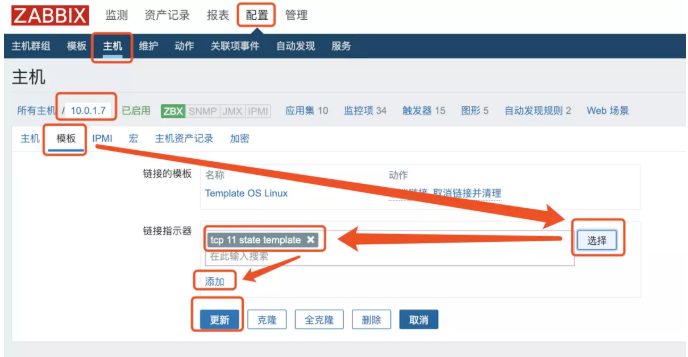
7.查看最新数据
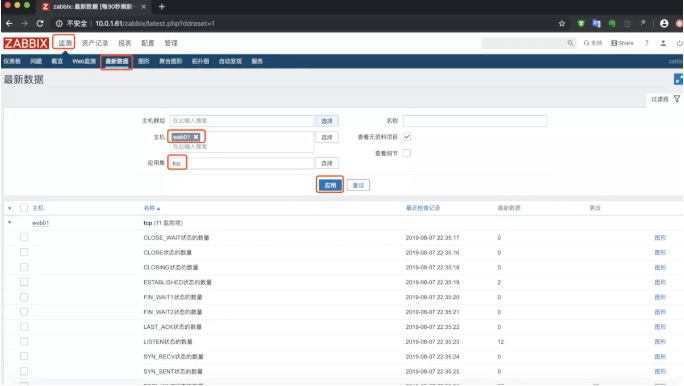
8.查看图形
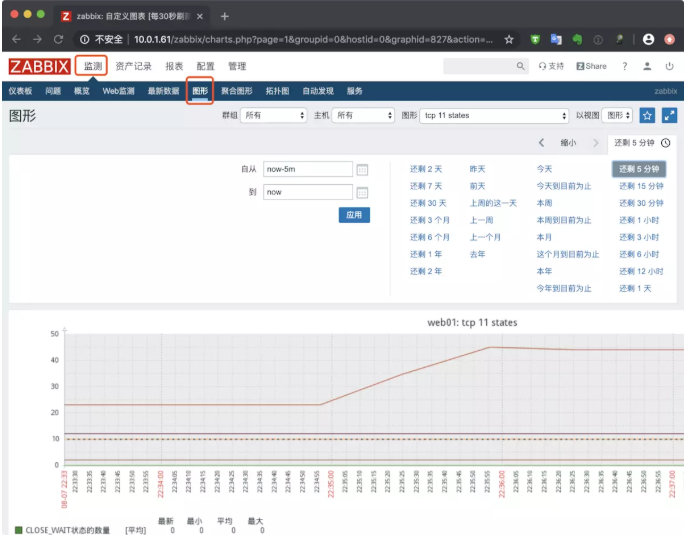
第十一章 聚合图形



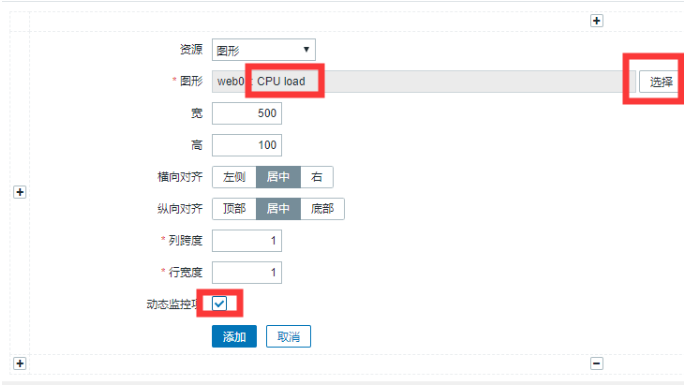
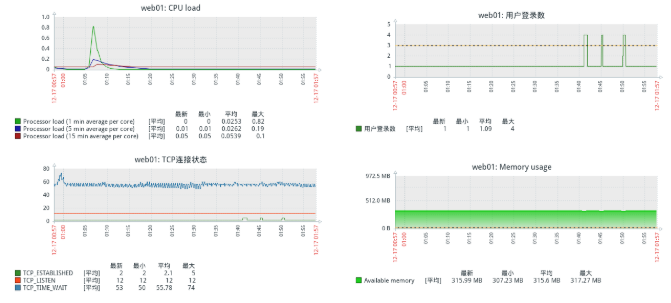
第x章 自定义模版监控nginx状态
1.开启监控页面并访问测试
[root@web01 ~]# cat /etc/nginx/conf.d/status.conf
server {
listen 80;
server_name localhost;
location /nginx_status {
stub_status on;
access_log off;
}
}
[root@web01 ~]# curl 127.0.0.1/nginx_status/
Active connections: 1
server accepts handled requests
6 6 6
Reading: 0 Writing: 1 Waiting: 0
2.准备nginx监控状态脚本
[root@web01 /etc/zabbix/zabbix_agentd.d]# cat nginx_monitor.sh
#!/bin/bash
NGINX_COMMAND=$1
CACHEFILE="/tmp/nginx_status.txt"
CMD="/usr/bin/curl http://127.0.0.1/nginx_status/"
if [ ! -f $CACHEFILE ];then
$CMD >$CACHEFILE 2>/dev/null
fi
# Check and run the script
TIMEFLM=`stat -c %Y $CACHEFILE`
TIMENOW=`date +%s`
if [ `expr $TIMENOW - $TIMEFLM` -gt 60 ]; then
rm -f $CACHEFILE
fi
if [ ! -f $CACHEFILE ];then
$CMD >$CACHEFILE 2>/dev/null
fi
nginx_active(){
grep 'Active' $CACHEFILE| awk '{print $NF}'
exit 0;
}
nginx_reading(){
grep 'Reading' $CACHEFILE| awk '{print $2}'
exit 0;
}
nginx_writing(){
grep 'Writing' $CACHEFILE | awk '{print $4}'
exit 0;
}
nginx_waiting(){
grep 'Waiting' $CACHEFILE| awk '{print $6}'
exit 0;
}
nginx_accepts(){
awk NR==3 $CACHEFILE| awk '{print $1}'
exit 0;
}
nginx_handled(){
awk NR==3 $CACHEFILE| awk '{print $2}'
exit 0;
}
nginx_requests(){
awk NR==3 $CACHEFILE| awk '{print $3}'
exit 0;
}
case $NGINX_COMMAND in
active)
nginx_active;
;;
reading)
nginx_reading;
;;
writing)
nginx_writing;
;;
waiting)
nginx_waiting;
;;
accepts)
nginx_accepts;
;;
handled)
nginx_handled;
;;
requests)
nginx_requests;
;;
*)
echo 'Invalid credentials';
exit 2;
esac
3.编写zabbix监控配置文件
[root@web01 ~]# cat /etc/zabbix/zabbix_agentd.d/nginx_status.conf
UserParameter=nginx_status[*],/bin/bash /etc/zabbix/zabbix_agentd.d/nginx_monitor.sh $1
[root@web01 ~]# systemctl restart zabbix-agent.service
4.使用zabbix_get取值
[root@m01 ~]# zabbix_get -s 10.0.1.7 -k nginx_status[accepts]
7
5.导入模版
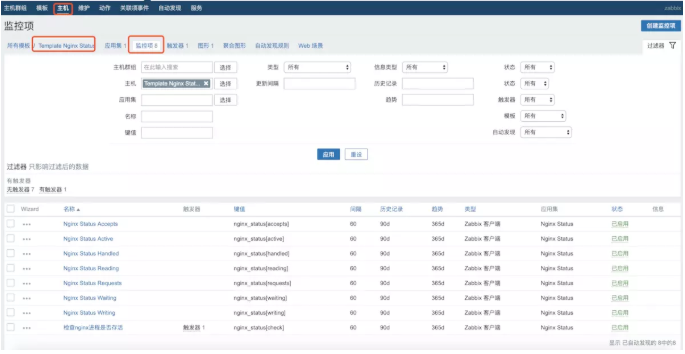
6.链接模版
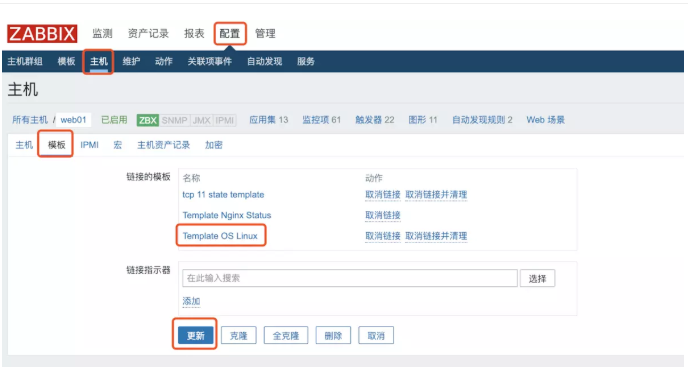
7.查看数据
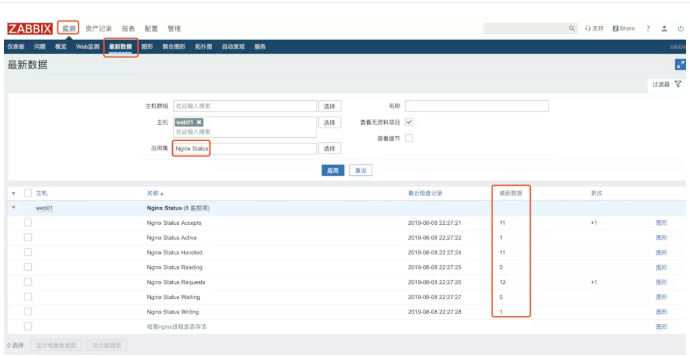
第x章 自定义模版监控php状态
1.开启监控页面
[root@web01 ~]# tail -1 /etc/php-fpm.d/www.conf
pm.status_path = /php_status
[root@web01 ~]# cat /etc/nginx/conf.d/status.conf
server {
listen 80;
server_name localhost;
location /nginx_status {
stub_status on;
access_log off;
}
location /php_status {
fastcgi_pass 127.0.0.1:9000;
fastcgi_index index.php;
fastcgi_param SCRIPT_FILENAME html$fastcgi_script_name;
include fastcgi_params;
}
}
[root@web01 ~]# nginx -t
nginx: the configuration file /etc/nginx/nginx.conf syntax is ok
nginx: configuration file /etc/nginx/nginx.conf test is successful
[root@web01 ~]# systemctl restart nginx.service php-fpm.service
2.访问测试
[root@web01 ~]# curl 127.0.0.1/php_status
pool: www
process manager: dynamic
start time: 08/Aug/2019:22:31:27 +0800
start since: 37
accepted conn: 1
listen queue: 0
max listen queue: 0
listen queue len: 128
idle processes: 4
active processes: 1
total processes: 5
max active processes: 1
max children reached: 0
slow requests: 0
3.准备访问脚本
[root@web01 ~]# cat /etc/zabbix/zabbix_agentd.d/fpm.sh
#!/bin/bash
##################################
# Zabbix monitoring script
#
# php-fpm:
# - anything available via FPM status page
#
##################################
# Contact:
# vincent.viallet@gmail.com
##################################
# ChangeLog:
# 20100922 VV initial creation
##################################
# Zabbix requested parameter
ZBX_REQ_DATA="$1"
ZBX_REQ_DATA_URL="$2"
# Nginx defaults
NGINX_STATUS_DEFAULT_URL="http://localhost/fpm/status"
WGET_BIN="/usr/bin/wget"
#
# Error handling:
# - need to be displayable in Zabbix (avoid NOT_SUPPORTED)
# - items need to be of type "float" (allow negative + float)
#
ERROR_NO_ACCESS_FILE="-0.91"
ERROR_NO_ACCESS="-0.92"
ERROR_WRONG_PARAM="-0.93"
ERROR_DATA="-0.94" # either can not connect / bad host / bad port
# Handle host and port if non-default
if [ ! -z "$ZBX_REQ_DATA_URL" ]; then
URL="$ZBX_REQ_DATA_URL"
else
URL="$NGINX_STATUS_DEFAULT_URL"
fi
# save the nginx stats in a variable for future parsing
NGINX_STATS=$($WGET_BIN -q $URL -O - 2>/dev/null)
# error during retrieve
if [ $? -ne 0 -o -z "$NGINX_STATS" ]; then
echo $ERROR_DATA
exit 1
fi
#
# Extract data from nginx stats
#
#RESULT=$(echo "$NGINX_STATS" | awk 'print $0;match($0, "^'"$ZBX_REQ_DATA"':[[:space:]]+(.*)", a) { print a[1] }')
#RESULT=$(echo "$NGINX_STATS" | grep "$ZBX_REQ_DATA" | awk -F : '{print $2}')
RESULT=$(echo "$NGINX_STATS" | awk -F : "{if(\$1==\"$ZBX_REQ_DATA\") print \$2}")
if [ $? -ne 0 -o -z "$RESULT" ]; then
echo $ERROR_WRONG_PARAM
exit 1
fi
echo $RESULT
exit 0
[root@web01 ~]# bash /etc/zabbix/zabbix_agentd.d/fpm.sh "total processes" http://127.0.0.1/php_status
5
4.准备zabbix配置文件
[root@web01 ~]# cat /etc/zabbix/zabbix_agentd.d/fpm.conf
UserParameter=php-fpm[*],/etc/zabbix/zabbix_agentd.d/fpm.sh "$1" "$2"
[root@web01 ~]# systemctl restart zabbix-agent.service
5.使用zabbix_get取值
[root@m01 ~]# zabbix_get -s 10.0.1.7 -k php-fpm["total processes",http://127.0.0.1/php_status]
5
6.导入模版
导入之后需要修改一下模版里的宏配置

第x章 WEB监控
需求,监控页面状态码
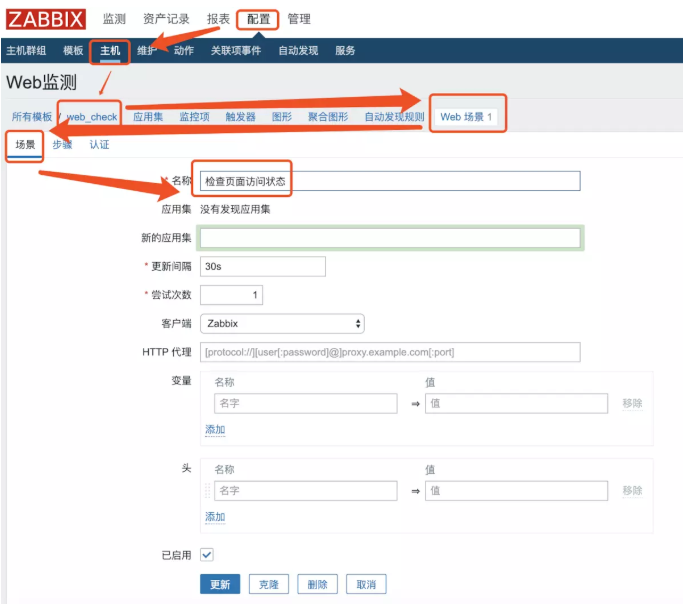
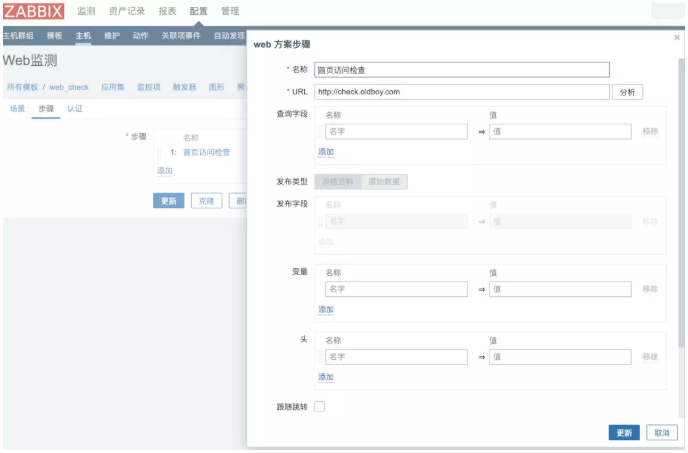

第x章 故障记录
故障1
故障现象:
提示zabbix-server is not running
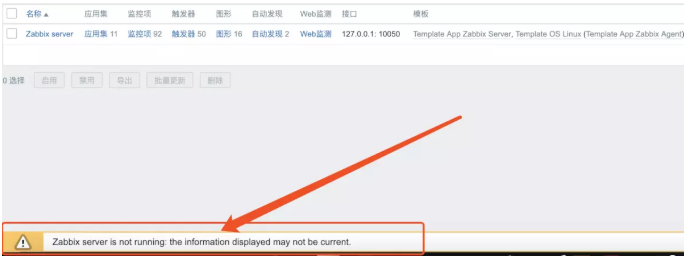
报错日志:
34983:20190807:202215.171 database is down: reconnecting in 10 seconds
34983:20190807:202225.172 [Z3001] connection to database 'zabbix' failed: [1045] Access denied for user 'zabbix'@'localhost' (using password: NO)
故障原因:
zabbix-server的配置文件里配有配置数据库密码
故障解决:
添加正确的数据库账号密码信息
[root@m01 ~]# grep "^DB" /etc/zabbix/zabbix_server.conf
DBHost=localhost
DBName=zabbix
DBUser=zabbix
DBPassword=zabbix
故障2
故障现象:微信报警失败
报错日志:
[root@m01 ~]# tail -f /var/log/zabbix/zabbix_server.log
Problem name: TIME_WAIT过多
Host: web01
Severity: Average
Original problem ID: 51
'": Traceback (most recent call last):
File "/usr/lib/zabbix/alertscripts/weixin.py", line 7, in <module>
import requests
ImportError: No module named requests
问题原因:
缺少模块 requests
问题解决:
安装缺失的依赖包
[root@m01 ~]# yum install python-pip
[root@m01 ~]# pip install --upgrade pip
[root@m01 ~]# pip install requests
故障3
故障现象:
在server端使用zabbix_get命令测试键值命令时提示警告
[root@m01 ~]# zabbix_get -s 10.0.1.7 -k ESTABLISHED
(Not all processes could be identified, non-owned process info
will not be shown, you would have to be root to see it all.)
2
问题原因:
zabbix_agent是以普通用户zabbix运行的,而普通用户执行netstat -antp时会有警告,网上查找发现只要不是用p参数就可以以普通用户运行
解决方案:
监控脚本里的命令修改为netstat -ant


